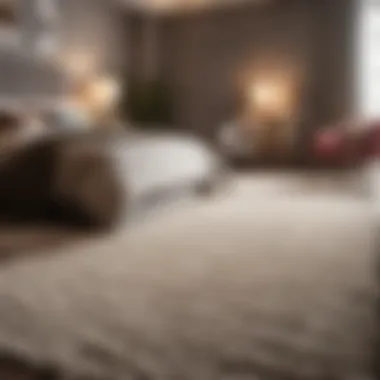Materials:
- High-quality carpet: 300 sq. ft. of plush textured carpet in a neutral tone
- Carpet padding: 300 sq. ft. of durable and thick padding
- Tack strips: 50 linear feet of high-quality tack strips
- Carpet adhesive: 1 gallon of solvent-free adhesive
- Seam tape: Sufficient amount for seam sealing
- Transition strips: 4 strips for seamless finishing
DIY Steps:
- Prepare the Room: Clear the room of furniture and ensure the subfloor is clean and level.
- Measure and Cut: Measure the room dimensions accurately and cut the underlay and carpet to fit.
- Install Padding: Lay the padding smoothly across the floor and trim any excess.
- Lay the Carpet: Roll out the carpet and ensure it aligns correctly with the walls, then secure with tack strips.
- Trim and Seam: Trim excess carpet along edges and use seam tape to join pieces seamlessly.
- Finish with Transitions: Install transition strips at doorways for a professional look.
Technical Aspects:
- Tools: Utility knife, knee-kicker, carpet stretcher, trimmer, seam roller
- Timing: Allow 1-2 days for completion, depending on room size and complexity.
- Critical Techniques: Proper stretching, cutting, and seamless seam sealing are crucial.
DIY Project Process:


- Lay out the carpet and padding, ensuring they fit the room dimensions precisely.
- Smooth out any wrinkles and securely attach the carpet to the tack strips.
- Trim excess material carefully, especially around corners and edges.
- Use seam tape to fuse carpet pieces together seamlessly.
- Install transition strips for a polished look at entryways.
Troubleshooting Tips:


- Wrinkles? Use a knee-kicker to pull the carpet taut.
- Uneven cuts? Always measure twice and cut once.
- Seams not blending? Trim excess and reapply seam tape as needed.
Introduction


In the realm of interior design and home improvement, the selection of carpeting plays a crucial role in shaping the ambiance and functionality of a bedroom. Understanding the nuances of cost implications when it comes to carpeting a bedroom empowers homeowners to make informed decisions that not only enhance the aesthetic appeal of their living space but also optimize comfort and insulation levels. This comprehensive guide not only delves into the financial aspects of carpet installation but also sheds light on the broader impact that quality carpeting can have on the overall quality of life within the home.
Understanding the Importance of Quality Carpeting
Impact on Room Aesthetics
Quality carpeting significantly influences the aesthetics of a bedroom, serving as a foundational element in the overall design scheme. The choice of carpet material, texture, and color can elevate the visual appeal of the space, imparting a sense of softness and warmth that is unrivaled by other flooring options. Opting for high-quality carpeting ensures a luxurious look and feel, enhancing the room's atmosphere and creating a cozy retreat. While premium carpets may entail a higher initial investment, their durable nature and timeless elegance make them a favorable choice for homeowners seeking long-term value and sophistication in their living environment.
Comfort and Insulation Benefits
Aside from its visual impact, quality carpeting offers unparalleled comfort and insulation benefits that positively impact daily living. The plush surface of a well-chosen carpet provides a soft underfoot feel, reducing noise levels and creating a relaxing environment conducive to rest and relaxation. Furthermore, carpets act as natural insulators, helping to maintain stable room temperatures and reduce energy consumption. This not only contributes to a more comfortable indoor climate but also adds a layer of cost-efficiency to the overall maintenance of the bedroom. In considering the installation of quality carpeting, homeowners can look forward to enhanced comfort, reduced energy bills, and a cozy living space that promotes overall well-being.
Factors Affecting the Cost
Carpeting a bedroom involves various factors that significantly influence the overall cost. Understanding these elements is crucial for making informed decisions when it comes to carpet installation. Factors such as the carpet material and quality, room size and shape, and installation complexity all play a vital role in determining the total expenses involved in the project. By delving deep into these aspects, individuals can budget accurately and choose the most suitable options for their specific needs.
Carpet Material and Quality
When it comes to carpet material and quality, several options are available, each with its own set of characteristics and advantages.
Nylon
Nylon is one of the most popular carpet materials due to its durability and resilience. Known for its ability to resist stains and wear, nylon carpets are a practical choice for high-traffic areas in the bedroom. The key characteristic of nylon is its ability to maintain its appearance over time, making it a long-lasting and cost-effective option. While nylon carpets may come at a slightly higher price point, the investment is justified by their exceptional performance and aesthetic appeal.
Polyester
Polyester carpets are a budget-friendly alternative to nylon, offering softness and comfort underfoot. The key characteristic of polyester is its vibrant color options and resistance to fading, making it a popular choice for homeowners seeking a visually appealing carpet. While polyester may not be as durable as nylon, it provides a cozy feel and easy maintenance, making it ideal for bedrooms where comfort is a priority.
Wool
Wool carpets are renowned for their luxurious feel and natural warmth. The key characteristic of wool is its unmatched softness and insulation properties, creating a cozy atmosphere in the bedroom. While wool may require more maintenance compared to synthetic materials, its eco-friendly nature and superior comfort make it a premium choice for those willing to invest in quality and sustainability.
Room Size and Shape
The size and shape of the room are essential considerations when determining the cost of carpeting.
Square Footage
The square footage of the bedroom directly impacts the amount of carpet needed and, therefore, the total cost of the project. Larger rooms will require more carpeting material, leading to higher expenses. Calculating the precise square footage can help individuals estimate the carpeting costs accurately and avoid unnecessary overspending.
Irregular Shapes
Rooms with irregular shapes or unique layouts pose a challenge when it comes to carpet installation. Special attention must be paid to accurate measurements and custom fitting to ensure a seamless and visually appealing result. While irregular shapes can complicate the installation process, taking the time to plan and address these challenges upfront can ultimately lead to a successful and cost-effective carpeting project.
Installation Complexity
The complexity of the installation process also contributes significantly to the overall cost of carpeting a bedroom.
Subfloor Preparation
Proper subfloor preparation is essential for ensuring the longevity and performance of the carpet. This stage involves removing old flooring, leveling the subfloor, and addressing any moisture issues. While subfloor preparation may add to the overall cost and timeline of the project, it is a critical step that sets the foundation for a durable and well-installed carpet.
Furniture Removal
Clearing the room of furniture before carpet installation is necessary to ensure a smooth and efficient process. Furniture removal services may incur additional fees, depending on the size and quantity of items. While some homeowners opt to move the furniture themselves to save on costs, professional removal services can offer convenience and peace of mind, especially for larger and heavier pieces.
Cost Breakdown
Carpet installation involves various cost factors that impact the overall expenses significantly. Understanding the breakdown of costs is crucial for anyone planning to carpet a bedroom. By delving into the specifics of each cost element, individuals can make informed decisions regarding their budget and choices. Analyzing the cost breakdown allows for a detailed assessment of where the money is allocated, ensuring that the investment in carpeting aligns with personal preferences and financial capabilities.
Carpet Costs
In the realm of carpeting, the cost per square foot plays a pivotal role in determining the total expenditure. When considering carpet costs, it is essential to assess the price per square foot as it directly influences the overall budget for the project. Different types of carpet materials vary in cost per square foot, with factors like quality and durability affecting the pricing. Understanding the nuances of the per square foot cost enables individuals to choose a carpet that fits their budget without compromising on quality.
Installation Fees
Installation fees encompass labor charges and additional services that contribute significantly to the total cost of carpeting a bedroom. Labor charges represent the costs associated with professional installers who ensure the carpet is fitted correctly and efficiently. These charges vary depending on the complexity of the installation process and the size of the room. Additional services may include tasks like furniture removal or subfloor preparation, enhancing the overall finish of the carpeting. Considering these installation fees is vital for planning a realistic budget and ensuring the successful execution of the project.
Additional Expenses
Apart from carpet and installation costs, additional expenses such as padding and transition strips should also be factored into the budget. Padding is a crucial component that provides cushioning and insulation beneath the carpet, enhancing its longevity and comfort. Transition strips, on the other hand, offer a smooth and seamless transition between different flooring surfaces, adding a polished look to the room. While these expenses may seem minor compared to the primary costs, they contribute significantly to the overall aesthetic and functionality of the carpeted space. Being mindful of these additional expenses ensures a comprehensive approach to carpeting a bedroom, focusing on both practicality and aesthetics.
DIY vs. Professional Installation
Pros and Cons
Cost Savings
Discussing the aspect of 'Cost Savings,' it is a pivotal consideration when comparing DIY versus professional installation. Cost savings play a crucial role in the decision-making process as it can significantly affect the total expenditure on the project. The key characteristic of cost savings lies in the potential reduction of labor costs and associated fees when opting for a DIY approach. This choice proves beneficial as it allows homeowners to save money that would typically be spent on professional installation services. However, the disadvantage of choosing cost savings through DIY lies in the potential risks of mistakes or subpar installation quality that may lead to additional expenses for corrections or replacements.
Quality Assurance
Turning to the element of 'Quality Assurance,' it holds paramount importance in ensuring a satisfactory outcome for the carpet installation project. Quality assurance offers the assurance of professional expertise and precision in the installation process, guaranteeing a high standard of workmanship and durability. This aspect is a popular choice for those seeking a flawless finish and long-term performance from their carpeting. The unique feature of quality assurance lies in the peace of mind it provides to homeowners, knowing that the installation is executed with precision and adherence to industry standards. However, the potential disadvantage of opting for professional installation for quality assurance is the higher upfront costs compared to a DIY approach, which may deter budget-conscious individuals.
Budgeting Tips
Budgeting tips play a crucial role in the comprehensive guide to the cost of carpeting a bedroom. When considering a home improvement project such as installing carpeting, having a well-thought-out budget can prevent unexpected expenses and ensure a smooth process from start to finish. By focusing on specific elements of budgeting tips, individuals can plan effectively and manage their finances wisely throughout the carpet installation project.
One key benefit of embracing budgeting tips in this context is the ability to estimate costs accurately. By outlining all potential expenses in advance and allocating funds properly, homeowners can avoid cost overruns and financial stress. Additionally, considering budgeting tips allows individuals to prioritize where to allocate more resources based on their preferences or necessary quality standards.
Moreover, budgeting tips prompt homeowners to evaluate the long-term value of their investment. By accounting for not only immediate costs but also future benefits and durability, individuals can make informed decisions that align with their lifestyle and financial goals. This consideration ensures that the carpeting choice not only meets immediate aesthetic and functional needs but also provides lasting value over time.
In essence, the section on budgeting tips encourages readers to approach carpeting projects with a strategic financial mindset, highlighting the importance of planning, foresight, and fiscal responsibility for a successful outcome.
Estimating Costs Accurately
Consulting Multiple Quotes
Consulting multiple quotes is a critical aspect of estimating costs accurately for a bedroom carpeting project. This step involves reaching out to various carpet suppliers and installation professionals to gather detailed pricing information on materials, labor, and additional services. By comparing multiple quotes, homeowners can gain a comprehensive understanding of the market rates, allowing them to make cost-effective decisions while ensuring quality.
Key characteristics of consulting multiple quotes include transparency, competitiveness, and customization. Transparency in pricing provides homeowners with a clear breakdown of costs, enabling them to assess the value offered by each provider. The competitive nature of quotes encourages suppliers to offer their best rates, potentially resulting in cost savings for the homeowner. Additionally, consulting multiple quotes allows for the customization of services and materials based on individual preferences and budget constraints.
One of the main advantages of consulting multiple quotes in this context is the potential for cost savings. By exploring different pricing options, homeowners can identify affordable solutions without compromising on quality. However, a disadvantage of this approach may involve the time and effort required to collect and compare numerous quotes, which could delay the project timeline.
Considering Long-Term Value
Considering the long-term value of carpeting choices is another essential factor in estimating costs accurately. This aspect prompts homeowners to look beyond immediate expenses and assess the durability, maintenance requirements, and longevity of different carpet materials and installation methods. By prioritizing long-term value, individuals can select options that not only fit their budget but also offer lasting benefits.
The key characteristic of considering long-term value lies in sustainability and investment justification. Sustainable carpeting choices that have low maintenance requirements and high durability can contribute significantly to long-term cost savings and environmental responsibility. Moreover, evaluating the investment justification involves weighing the upfront cost of carpeting against its expected lifespan and performance, ensuring a well-informed decision.
The advantage of considering long-term value when estimating costs is the potential for reduced overall expenses in the long run. Opting for high-quality materials that require minimal replacement or repair can lead to significant savings over time. However, a potential disadvantage could be the initial higher cost of products with superior long-term value, which may require a larger upfront investment.
Conclusion
In the intricate world of bedroom carpeting, the conclusion plays a pivotal role in guiding individuals towards making well-informed decisions. As we navigate the labyrinth of carpet cost concerns, the conclusion acts as the compass pointing us towards the optimal balance between expenses and quality outcomes. Understanding the nuances of cost considerations and the impact on overall room aesthetics and comfort is essential to achieving a satisfactory carpeting outcome. From the initial planning stages to the final penny spent, the conclusion encapsulates the essence of informed decision-making, urging us to tread carefully and purposefully in our carpet installation journey, ensuring a harmonious blend of cost-efficiency and luxurious quality.
Making Informed Decisions
Balancing Cost and Quality
In the pursuit of a well-carpeted bedroom, the delicate dance between cost and quality emerges as a critical focal point. Balancing cost and quality entails not merely seeking the cheapest option available but rather strategically investing in a carpet that harmonizes reasonable pricing with superior durability and aesthetic appeal. This equilibrium is no easy feat to achieve but is a hallmark of a successful carpeting project. The key characteristic of balancing cost and quality lies in judiciously selecting a carpet that offers a balanced mix of affordability and resilience, ensuring long-term satisfaction and financial prudence. While opting for budget-friendly choices may seem tempting, a thorough evaluation of quality standards ensures that compromises in longevity or visual appeal are reduced, providing a pragmatic, cost-effective solution to bedroom carpeting needs.
Investing in Durability
Investing in durability holds the key to unlocking the full potential of a well-carpeted bedroom. Priority given to durability translates into a well-thought-out decision-making process that emphasizes long-lasting performance over immediate cost considerations. The crux of investing in durability lies in opting for carpets constructed from robust materials and advanced manufacturing techniques, guaranteeing resilience against wear and tear, thereby extending the lifespan of the carpet significantly. A key characteristic of this approach is the foresight to view bedroom carpeting not as a transient expense but as a long-term investment in enhancing living spaces. The unique feature of durability investment is its ability to withstand heavy foot traffic, resist stains, and retain aesthetic value over time, making it a prudent choice for individuals seeking enduring quality and cost-effective solutions in their carpeting endeavors.





